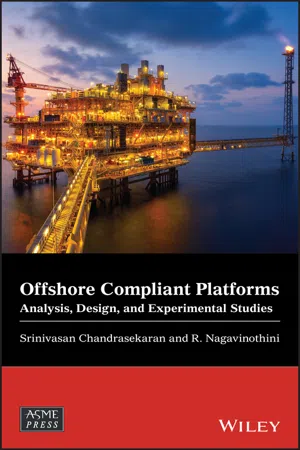
Offshore Compliant Platforms
Analysis, Design, and Experimental Studies
- English
- ePUB (mobile friendly)
- Available on iOS & Android
Offshore Compliant Platforms
Analysis, Design, and Experimental Studies
About this book
A guide to the analysis and design of compliant offshore structures that highlights a new generation of platforms
Offshore Compliant Platforms provides an authoritative guideto the analysis and design of compliant offshore structures and puts the focus on a new generation of platforms such as: triceratops, Buoyant Leg Storage and Regasification platforms. Whilst the authors – noted experts on the topic – include basic information on the conceptual development of conventional platforms, the book presents detailed descriptions of the design and development of new deep-water platforms.
The book describes the preliminary design of triceratops in ultra-deep waters and presents a detailed analysis of environmental loads that are inherent in offshore locations such as wave, wind and current. The new methodology for the dynamic analysis of triceratops under ice loads, predominantly in ice-covered regions, is also examined with detailed parametric studies. In addition, the book covers the structural geometry and the various methods of analysis for assessing the performance of any other similar offshore platform under the special loads. A discussion of the fatigue analysis and service life prediction is also included. This important book:
• Includes the analysis and design of compliant offshore structures with a focus on a new generation of platforms
• Examines the preliminary design of triceratops in ultra-deep waters
• Covers an analysis of environmental loads that are inherent in offshore locations such as wave, wind and current
• Reviews the structural geometry and various methods of analysis for assessing the performance of any other similar offshore platform under special loads
• Discusses fatigue analysis and service life prediction
Written for engineers and researchers across engineering including civil, mechanical, structural, offshore, ocean and naval architecture, Offshore Compliant Platforms fills the need for a guide to new offshore platforms that provides an understanding of the behaviour of these structures under different loading conditions.
Frequently asked questions
- Essential is ideal for learners and professionals who enjoy exploring a wide range of subjects. Access the Essential Library with 800,000+ trusted titles and best-sellers across business, personal growth, and the humanities. Includes unlimited reading time and Standard Read Aloud voice.
- Complete: Perfect for advanced learners and researchers needing full, unrestricted access. Unlock 1.4M+ books across hundreds of subjects, including academic and specialized titles. The Complete Plan also includes advanced features like Premium Read Aloud and Research Assistant.
Please note we cannot support devices running on iOS 13 and Android 7 or earlier. Learn more about using the app.
Information
1
Common Compliant Platforms
Summary
This chapter presents details of the structural geometry of compliant offshore platforms while emphasizing the design and development of these platforms rather than of fixed platforms. Details of investigations carried out on the response control of a tension leg platform (TLP) and an articulated tower are presented. This chapter also presents various control strategies that are commonly deployed for response control of structures subjected to lateral loads while presenting detailed applications of tuned mass dampers (TMDs) in offshore structures. Experimental investigations and numerical analyses, reported by R. Ranjani (2015, “Response Control of Tension Leg Platform Using Tuned Mass Damper,” PhD thesis, IIT Madras, India) and Prof. Deepak Kumar (Dept. of Ocean Engineering, IIT Madras, India) are sincerely acknowledged by the authors.
1.1 Introduction
Table of contents
- Cover
- Table of Contents
- List of Figures
- List of Tables
- Foreword by Professor Purnendu K. Das
- Foreword by Dr. Atmanand N.D.
- Series Preface
- Preface
- 1 Common Compliant Platforms
- 2 Buoyant Leg Storage and Regasification Platforms
- 3 New‐Generation Platforms: Offshore Triceratops
- 4 Triceratops Under Special Loads
- 5 Offshore Triceratops: Recent Advanced Applications
- Model Exam Paper 1
- References
- Index
- End User License Agreement